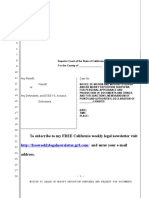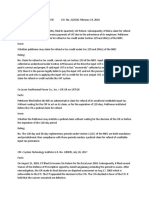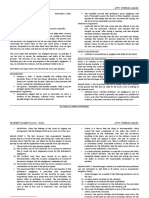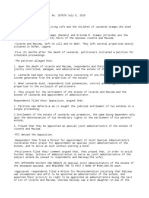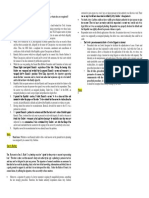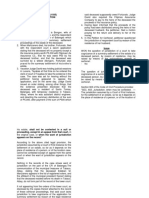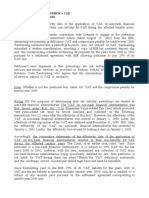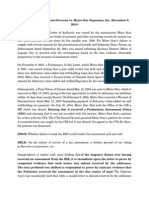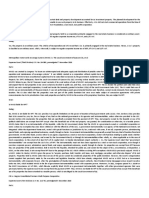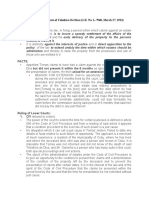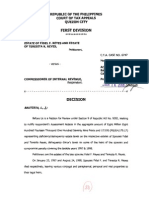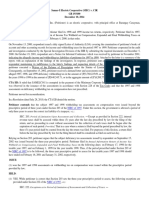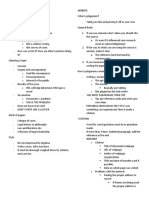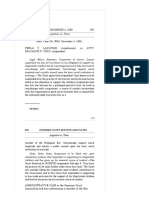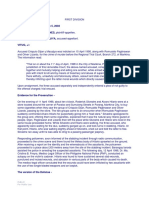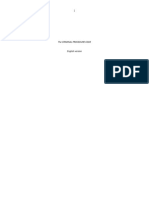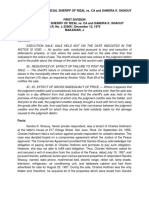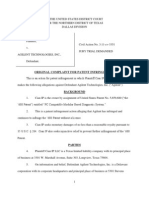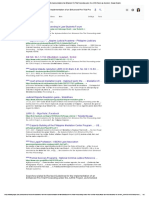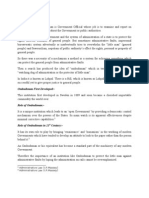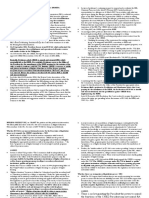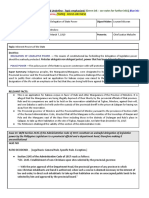CIR v. TEAM SUAL
CIR v. TEAM SUAL
Uploaded by
Dawn BernabeCopyright:
Available Formats
CIR v. TEAM SUAL
CIR v. TEAM SUAL
Uploaded by
Dawn BernabeOriginal Description:
Copyright
Available Formats
Share this document
Did you find this document useful?
Is this content inappropriate?
Copyright:
Available Formats
CIR v. TEAM SUAL
CIR v. TEAM SUAL
Uploaded by
Dawn BernabeCopyright:
Available Formats
CIR v. Team Sual Corporation, [G.R. No. 205055. July 18, 2014] 8.
CIR’S ARGUMENTS ON MR w/ CTA:
a. CIR further claims that TSC's petition for review was
SUMMARY prematurely filed, alleging that under Section 112( C)
Team Sual filed for a claim for refund of unutilized input VAT but without of the NIRC, the CIR is given 120 days from the
waiting for the 120 period within which the BIR can decide the case, TSC submission of complete documents within which to
filed a petition with review with the CTA seeking for refund. CTA granted either grant or deny TSC's application for refund/tax
TSC’s petition. CIR opposed saying that the CTA petition was prematurely credit.
filed because before filing a petition with the CTA, there must first be a b. The CIR pointed out that TSC filed its petition for review
decision by the BIR or the 120 period must have lapsed. SC agreed with the with the CTA sans any decision on its claim and without
CIR saying that the requirement for decision by the BIR/Lapse of the 120 - waiting for the 120-day period to lapse.
day period is mandatory and jurisdictional.
9. CTA denied MR:
DOCTRINE: . TSC's petition for review was not prematurely filed
An administrative claim for refund of unutilized input VAT must first be filed notwithstanding that the 120-day period had not yet lapsed.
with the BIR within the prescriptive period of 2 years from the close of the a. pursuant to Section 112(A) of the NIRC, claims for refund/tax
taxable quarter when the sales were made. Before a petition for review may credit of unutilized input VAT should be filed within two years after
be filed before the CTA, there must first be decision by the BIR OR the lapse the close of the taxable quarter when the sales were made;
of a 120 period from filing of complete documents in support of the b. that the 120-day period is also covered by the two-year
application. This requirement in mandatory and jurisdictional, any decision prescriptive period within which to claim the refund/tax credit.
rendered by the CTA without this is deemed void. c. Allison J. Gibbs, et al. vs. CIR: the suit or proceeding must be
started in this Court before the end of the two-year period without
FACTS awaiting the decision of the Collector (now Commissioner).
1. TSC is in the business of power generation and the sale to d. Unlike assessments, no decision of respondent is required before
National Power Corporation (NPC); it is registered as a VAT one can go to this Court for a claim of refund.
taxpayer. 10. CTA En Banc AFFIRMED
2. the CIR granted TSC's application for zero-rating arising from its . claimant may seek judicial redress for refund with the CTA either
sale of power generation services to NPC for the taxable year within 30 days from receipt of the denial of its claim for refund/tax credit,
2000 OR after the lapse of 120-day period in the event of inaction by the
3. As a VAT-registered entity, TSC filed its VAT returns for the Commissioner;
taxable year 2000. a. provided that both administrative and judicial remedies must be
4. On March 11, 2002, TSC filed with the BIR an administrative undertaken within the two (2)-year period from the close of the taxable
claim for refund of its unutilized input VAT in the amount of quarter when the relevant sales were made.
₱179,314,926.56 arising from its zero-rated sales to NPC for the b. If the two-year period is about to lapse, but the BIR has not
taxable year 2000. yet acted on the application for refund, the taxpayer should file a
5. On April 1, 2002, without awaitng the CIR's resolution of its Petition for Review with this Court within the two[-]year period.
administrative claim for refund/tax credit, TSC filed a petition for Otherwise, the claim is time-barred.
review with the CT A seeking the refund or the issuance of a ISSUES/HELD
tax credit certificate in the amount of ₱179,314,926.56 WN CTA en banc erred in holding that TSC's petition for review with the
6. CIR: TSC failed to comply with the conditions precedent for CT A was not prematurely filed - YES, FILING OF THE JUDICIAL CLAIM
claiming refund/tax credit of unutilized input VAT as it failed to IS PREMATURE
submit complete documents in support of its application for RATIO
refund/tax credit contrary to Section 112(C) of the NIRC
7. CTA: granted TSC's claim for refund/tax credit. but found that
that it was only able to substantiate the amount of 1. TSC filed its administrative claim within the two-year
₱173,265,261.30. prescriptive period. However, without waiting for the CIR decision or
the lapse of the 120-day period from the time it submitted its 3. The theory that the 30-day period must fall within the two-year
complete documents in support of its claim, TSC filed a petition for prescriptive results in truncating 120 days from the 730 days that the
review with the CTA on April 1,2002 - a mere 21 days after it filed its law grants the taxpayer for filing his administrative claim with the
administrative claim with the BIR. Commissioner.
Clearly, TSC's petition for review with the CTA was prematurely filed; 9. TSC submits that the requirement to exhaust the 120-day period
2. TS: non-observance of the 120-day period is not fatal to the filing of under Section 112(C) of the NIRC prior to filing the judicial claim with the
a judicial claim as long as both the administrative and the judicial CTA is a species of the doctrine of exhaustion of administrative remedies;
claims are filed within th 2 year period that the non-observance of the doctrine merely results in lack of cause of
3. SC: NO LEGAL BASIS! Sec.112 (A) states that "any VAT-registered action, which ground may be waived for failure to timely invoke the same.
person, whose sales are zero-rated or effectively zero-rated may, a. SC: NO- TSC's failure to comply with the 120-day mandatory period
within two years after the close of the taxable quarter when the sales renders its petition for review with the CTA void. It is a mere scrap of paper
were made, apply for the issuance of a tax credit certificate or refund from which TSC cannot derive or acquire any right notwithstanding the
of creditable input tax due or paid attributable to such sales." supposed failure on the part of the CIR to raise the issue of TSC' s non-
4. The phrase "within two (2) years x x x apply for the issuance of a tax compliance with the 120-day period in the proceedings before the CTA First
credit certificate or refund" refers to applications for refund/credit filed Division.
with the CIR and not to appeals made to the CTA. 10. TSC: under BIR Ruling No. DA-489-03 and RMC No. 49-03 had
5. Applying the two-year period to judicial claims would render nugatory already laid down the rule that the taxpayer-claimant need not wait for the
Section 112(C) of the NIRC, which already provides for a 30 day lapse of the 120-day period
period within which to appeal the decision or inaction of the CIR. ON RMC 49-03
6. CIR v San Roque: 120-day period that is given to the CIR within a. In San Roque, the Court had already clarified that nowhere in RMC
which to decide claims for refund/tax credit of unutilized input VAT is No. 49-03 was it stated that a taxpayer-claimant need not wait for the lapse
mandatory and jurisdictional. The taxpayer-claimant must wait for the of the 120-day mandatory period before it can file its judicial claim with the
120-day period to lapse otherwise, the petition would be rendered CTA. RMC No. 49-03 only authorized the BIR to continue the processing of a
premature and without a cause of action. IT would violate doctrine of claim for refund/tax credit notwithstanding that the same had been appealed
exhaustion of administrative remedies. to the CTA
a. CTA Charter: jurisdiction is to review on appeal "decisions of the b. Thus, if the taxpayer files its judicial claim before the expiration of the
Commissioner of Internal Revenue in cases involving x x x refunds of internal 120-day period, the BIR will nevertheless continue to act on the
revenue taxes." administrative claim because such premature filing cannot divest the
b. there is no "decision" of the Commissioner to review and CTA has no Commissioner of his statutory power and jurisdiction to decide the
jurisdiction over the appeal. administrative claim within the 120-day period.
7. That the two-year prescriptive period is about to lapse is ON BIR Ruling DA-489-03
inconsequential. a. BIR Ruling No. DA-489-03 does provide a valid claim for equitable
. The 120-day mandatory period may extend beyond the two-year estoppel under Section 246 of the Tax Code. BIR Ruling No. DA-489-03
prescriptive period. Consequently, the 30-day period given to the taxpayer- expressly states that the "taxpayer-claimant need not wait for the lapse of the
claimant likewise need not fall under the two-year prescriptive period. What 120-day period before it could seek judicial relief with the CT A by way of
matters is that the administrative claim is filed with the BIR within the two- Petition for Review."
year prescriptive period. b. the CTA does not acquire jurisdiction over a judicial claim that is filed
8. Why 30-day period need not necessarily fall within the two-year before the expiration of the 120-day period.
prescriptive period, as long as the administrative claim is filed within c. There are, however, two exceptions to this rule.
the two-year prescriptive period: i.The first exception is if the Commissioner, through a specific ruling, misleads
1.The application for refund or credit may be filed by the taxpayer a particular taxpayer to prematurely file a judicial claim with the CT A. Such
with the Commissioner on the last day of the two-year prescriptive specific ruling is applicable only to such particular taxpayer.
period and it will still strictly comply with the law. ii.The second exception is where the Commissioner, through a general
2. the two-year prescriptive period does not refer to the filing of the interpretative rule issued under Section 4 of the Tax Code, misleads all
judicial claim with the CTA but to the filing of the administrative claim taxpayers into filing prematurely judicial claims with the CTA.
with the Commissioner
d. In these cases, the Commissioner cannot be allowed to later on
question the CT A's assumption of jurisdiction over such claim since
equitable estoppel has set in
e. BIR Ruling No. DA-489-03 is a general interpretative rule because it
was a response to a query made by a government agency ( the One Stop
Shop Inter-Agency Tax Credit and Drawback Center of the Department of
Finance)
f. Being a general interpretative rule, the CIR is barred from
questioning the CTA's assumption of jurisdiction since estoppel under
Section 246 of the NIRC had already set in
24
g. Nevertheless, the Court clarified that taxpayers can only rely on BIR
Ruling No. DA-489-03 from the time of its issuance on December 10, 2003
up to its reversal by this Court in Aichi on October 6, 2010
2. TSC: Court's ruling in Aichi should only be applied prospectively; that
prior to Aichi, the Court supposedly ruled that a taxpayer-claimant
need not await the lapse of the 120-day period. The Court does not
agree.
. There is no basis to TSC's claim that this Court. Cases cited by TSC
do not support its contention.
3. Even if TSC was able to substantiate that it is indeed entitled to a
refund/tax credit, its claim would still have to be denied.
. "Tax refunds are in the nature of tax exemptions, and are to be
construed strictissimi Juris against the entity claiming the same."
a. "The taxpayer is charged with the heavy burden of proving that he
hascomplied with and satisfied all the statutory and administrative
requirements to be entitled to the tax refund
b. TSC, in prematurely filing a petition for review with the CTA, failed to
comply with the 120-day mandatory period under Section 112(C) of the
NIRC. Thus, TSC's
claim for refund/tax credit of its unutilized input VAT should be denied.
DISPOSITIVE
WHEREFORE, the petition is GRANTED
You might also like
- Family Code SempioDiyDocument125 pagesFamily Code SempioDiyNikki Tricia Reyes Santos100% (8)
- Sample Motion To Quash or Modify Deposition Subpoena in CaliforniaDocument4 pagesSample Motion To Quash or Modify Deposition Subpoena in CaliforniaStan Burman75% (4)
- Tax Case DigestsDocument34 pagesTax Case DigestsFait Hee100% (1)
- 28 Gibbs v. CommissionerDocument2 pages28 Gibbs v. CommissionerDannaIngaran100% (1)
- CIR vs. DKS - Case DigestDocument4 pagesCIR vs. DKS - Case DigestJenova Jireh0% (1)
- Exparte Motion To Stay Pending Appeal and Civil Case FontanaDocument9 pagesExparte Motion To Stay Pending Appeal and Civil Case Fontanaaquauris33136100% (1)
- (See Rule - ) Registration Certificate Issued Under SectionDocument4 pages(See Rule - ) Registration Certificate Issued Under SectionAnonymous gabKypRNo ratings yet
- CIR V Univation MotorDocument3 pagesCIR V Univation MotoriptrinidadNo ratings yet
- GR 120935 - Adamson Vs CIRDocument11 pagesGR 120935 - Adamson Vs CIRJane MarianNo ratings yet
- Ericsson Telecommunications, Inc. vs. City of PasigDocument9 pagesEricsson Telecommunications, Inc. vs. City of PasigChristian Joe QuimioNo ratings yet
- CIR Vs SuyocDocument1 pageCIR Vs SuyocArnold JoseNo ratings yet
- AMERICAN POWER CONVERSION CORPORATION Vs LIMDocument23 pagesAMERICAN POWER CONVERSION CORPORATION Vs LIMRothea SimonNo ratings yet
- Heirs of Franco Vs CADocument2 pagesHeirs of Franco Vs CASarah Monique Nicole Antoinette GolezNo ratings yet
- 2017-18 Tax Case DigestDocument2 pages2017-18 Tax Case DigestRay Marvin Anor Palma100% (1)
- City of Taylor, TIFA Lawsuit Against Wayne CountyDocument132 pagesCity of Taylor, TIFA Lawsuit Against Wayne CountyDavid KomerNo ratings yet
- 6 ACMDC v. CIRDocument35 pages6 ACMDC v. CIRDaley CatugdaNo ratings yet
- 2ND Wave Case 11 Cir VS GJMDocument2 pages2ND Wave Case 11 Cir VS GJMChristian Delos ReyesNo ratings yet
- Vivencio Dalit V.S. Spouses BalagtasDocument3 pagesVivencio Dalit V.S. Spouses BalagtasSORITA LAWNo ratings yet
- 4 - Capili Vs Cardana Digest PDFDocument2 pages4 - Capili Vs Cardana Digest PDFNeapolle FleurNo ratings yet
- RCBC vs. CIRDocument1 pageRCBC vs. CIRAldrin TangNo ratings yet
- Ocampo vs. Ocampo G.R. No. 187879 July 5, 2010Document2 pagesOcampo vs. Ocampo G.R. No. 187879 July 5, 2010Jay CruzNo ratings yet
- Republic v. KenrickDocument1 pageRepublic v. KenrickKenneth Ray TagleNo ratings yet
- Sky Cable Vs CtaDocument11 pagesSky Cable Vs CtaAriel Mark PilotinNo ratings yet
- Verification and Certification of Non Forum ShoppingDocument6 pagesVerification and Certification of Non Forum ShoppingRonz RoganNo ratings yet
- 09 Manzanero v. CFI - Rule 73Document2 pages09 Manzanero v. CFI - Rule 73Paolo Ervin Perez0% (1)
- Fishwealth Canning Corp Vs Cir (GR 179343 January 21 2010)Document2 pagesFishwealth Canning Corp Vs Cir (GR 179343 January 21 2010)Brian BaldwinNo ratings yet
- H. Tambunting V CIRDocument1 pageH. Tambunting V CIRMark Gabriel B. MarangaNo ratings yet
- CIR vs. Metro Star (TAX)Document3 pagesCIR vs. Metro Star (TAX)Teff QuibodNo ratings yet
- Tax BulletinDocument15 pagesTax BulletinSiadeel HomesNo ratings yet
- Steag State Power Inc. v. CIRDocument10 pagesSteag State Power Inc. v. CIRClarence ProtacioNo ratings yet
- CIR v. Philippine Global CommunicationsDocument3 pagesCIR v. Philippine Global CommunicationsDaLe AparejadoNo ratings yet
- Digest Cases 51-60Document6 pagesDigest Cases 51-60Vince HonarableNo ratings yet
- MBTC v. CIRDocument3 pagesMBTC v. CIRAngelique Padilla UgayNo ratings yet
- G.R. No. 227544 Commissioner OF Internal REVENUE, Petitioner Transitions Optical Philippines, Inc., Respondent Decision Leonen, J.Document7 pagesG.R. No. 227544 Commissioner OF Internal REVENUE, Petitioner Transitions Optical Philippines, Inc., Respondent Decision Leonen, J.JaysonNo ratings yet
- 35 Philippine Dream Company Inc. V.20210424-12-1jxqs4iDocument11 pages35 Philippine Dream Company Inc. V.20210424-12-1jxqs4iervingabralagbonNo ratings yet
- MANOTOC v. CA and TRAJANODocument3 pagesMANOTOC v. CA and TRAJANOGilbert John LacorteNo ratings yet
- Divine Word High School Vs NLRCDocument3 pagesDivine Word High School Vs NLRCVince LeidoNo ratings yet
- 46 in The Matter of Estate of Telesforo de Dios - Case DIgestDocument3 pages46 in The Matter of Estate of Telesforo de Dios - Case DIgestGoodyNo ratings yet
- CIR Vs Pascor Realty DigestDocument1 pageCIR Vs Pascor Realty DigestMa Arnee LopezNo ratings yet
- Team Energy Corp Vs CIRDocument8 pagesTeam Energy Corp Vs CIRJenifferRimandoNo ratings yet
- 1 Sta. Lucia Realty & Development, Inc. vs. City of Pasig PDFDocument9 pages1 Sta. Lucia Realty & Development, Inc. vs. City of Pasig PDFPS PngnbnNo ratings yet
- Estate of Reyes v. CIRDocument31 pagesEstate of Reyes v. CIRCon ConNo ratings yet
- People vs. QuiachonDocument7 pagesPeople vs. QuiachonJonimar Coloma QueroNo ratings yet
- Pacquiao V CTADocument3 pagesPacquiao V CTACatherine DiestaNo ratings yet
- A. Tax Assessment - Xiii. RCBC vs. CIR, GR No. 170257, 7 September 2011Document2 pagesA. Tax Assessment - Xiii. RCBC vs. CIR, GR No. 170257, 7 September 2011VINCENTREY BERNARDONo ratings yet
- CIR vs. United Salvage and Towage, 2014 - CTA - Technical Rules of Evidence - PAN - FANDocument16 pagesCIR vs. United Salvage and Towage, 2014 - CTA - Technical Rules of Evidence - PAN - FANhenzencameroNo ratings yet
- GR CIR Vs Optical TransitionDocument9 pagesGR CIR Vs Optical TransitionJoey SulteNo ratings yet
- Philippine Bank of Communications vs. Commissioner of Internal Revenue (GR 112024. Jan. 28, 1999)Document2 pagesPhilippine Bank of Communications vs. Commissioner of Internal Revenue (GR 112024. Jan. 28, 1999)Col. McCoyNo ratings yet
- Gibson v. RevillaDocument1 pageGibson v. RevillaReymart-Vin Maguliano100% (1)
- University Physicians Services Inc. - Management, INC., Petitioner Commissioner of Internal Revenue, RespondentDocument2 pagesUniversity Physicians Services Inc. - Management, INC., Petitioner Commissioner of Internal Revenue, RespondentJomong0% (1)
- Bustos vs. Millians Shoe, Inc.Document12 pagesBustos vs. Millians Shoe, Inc.Krystal Grace D. PaduraNo ratings yet
- Cir V Smart CommunicationDocument2 pagesCir V Smart CommunicationAnonymous Ig5kBjDmwQNo ratings yet
- Samar-I Electric Cooperative v. CIRDocument2 pagesSamar-I Electric Cooperative v. CIRTzarlene Cambaliza100% (1)
- Commissioner of Internal Revenue vs. Toshiba Information Equipment (Phils.), Inc., 466 SCRA 211, August 09, 2005Document4 pagesCommissioner of Internal Revenue vs. Toshiba Information Equipment (Phils.), Inc., 466 SCRA 211, August 09, 2005idolbondocNo ratings yet
- Philippine Veterans Bank V BCDADocument1 pagePhilippine Veterans Bank V BCDAda_sein32No ratings yet
- Samar Electric Cooperative vs. CIRDocument3 pagesSamar Electric Cooperative vs. CIRAnneNo ratings yet
- Pamonag - Accenture Inc. vs. Commissioner of The Internal RevenueDocument4 pagesPamonag - Accenture Inc. vs. Commissioner of The Internal RevenueNoel Christopher G. BellezaNo ratings yet
- CIR v. AcesiteDocument4 pagesCIR v. AcesiteTheresa BuaquenNo ratings yet
- Aniceto G. Saludo, JR., Petitioner, vs. American Express International, Inc., And:Or Ian T. Fish and Dominic Mascrinas, Respondents.Document3 pagesAniceto G. Saludo, JR., Petitioner, vs. American Express International, Inc., And:Or Ian T. Fish and Dominic Mascrinas, Respondents.arden1im100% (1)
- 10 Pigcaulan v. Security and CreditDocument2 pages10 Pigcaulan v. Security and CreditslumbaNo ratings yet
- #45 - CIR vs. Next Mobile Inc.-Delos ReyesDocument2 pages#45 - CIR vs. Next Mobile Inc.-Delos ReyesMilesNo ratings yet
- CIR V Deutsche Knowledge ServicesDocument3 pagesCIR V Deutsche Knowledge ServicesRobert Manto100% (1)
- CIR V Deutsche Knowledge ServicesDocument3 pagesCIR V Deutsche Knowledge ServicesWilbert ChongNo ratings yet
- 098 CIR v. Hedcor Sibulan, Inc. (Uy)Document4 pages098 CIR v. Hedcor Sibulan, Inc. (Uy)Avie UyNo ratings yet
- Legal Writing LectureDocument2 pagesLegal Writing LectureDawn BernabeNo ratings yet
- 2 People V VeridianoDocument2 pages2 People V VeridianoDawn BernabeNo ratings yet
- Pelizloy Realty v. BenguetDocument2 pagesPelizloy Realty v. BenguetDawn Bernabe100% (1)
- Estanislao V CA - AgencyDocument2 pagesEstanislao V CA - AgencyDawn BernabeNo ratings yet
- Anti-Sexual Harassment Act of 2016Document3 pagesAnti-Sexual Harassment Act of 2016Dawn BernabeNo ratings yet
- Conflict of Laws - AznarDocument6 pagesConflict of Laws - AznarDawn BernabeNo ratings yet
- Boston Bank V ManaloDocument3 pagesBoston Bank V ManaloDawn BernabeNo ratings yet
- Human Relations TortsDocument13 pagesHuman Relations TortsDawn BernabeNo ratings yet
- Ordinance No. SP. 2501, S-2016Document12 pagesOrdinance No. SP. 2501, S-2016Dawn BernabeNo ratings yet
- Law and TechonologyDocument2 pagesLaw and TechonologyDawn BernabeNo ratings yet
- Clemente V GalvanDocument2 pagesClemente V GalvanDawn BernabeNo ratings yet
- SEPT 20 ReviewerDocument13 pagesSEPT 20 ReviewerDawn BernabeNo ratings yet
- A4 Principles of Taxation and Tax Remedies Reviewer: 1.1 Nature, Scope, Classifications and Essential CharacteristicsDocument38 pagesA4 Principles of Taxation and Tax Remedies Reviewer: 1.1 Nature, Scope, Classifications and Essential CharacteristicscharlesjoshdanielNo ratings yet
- A R Antulay v. R.S NayakDocument41 pagesA R Antulay v. R.S NayakPrashantKumar0% (1)
- Tiu San vs. RepublicDocument2 pagesTiu San vs. RepublicKarl AkiatanNo ratings yet
- Laguitan vs. TinioDocument5 pagesLaguitan vs. TinioAngelie FloresNo ratings yet
- 13) People v. Dijan, 383 SCRA 15Document5 pages13) People v. Dijan, 383 SCRA 15Nurlailah AliNo ratings yet
- 1963 Criminal Procedure Code of Somalia - English VersionDocument105 pages1963 Criminal Procedure Code of Somalia - English Versionصقر قريشNo ratings yet
- IDI - C1 - Gen Prov - Section3Document7 pagesIDI - C1 - Gen Prov - Section3klf1995No ratings yet
- The Provincial Sheriff of Rizal vs. CA and Sandra K. ShaouyDocument2 pagesThe Provincial Sheriff of Rizal vs. CA and Sandra K. ShaouyVanityHugh100% (1)
- Sanchez V BuenaviajieDocument1 pageSanchez V BuenaviajieCelinka ChunNo ratings yet
- Bayog-Ang V QuinonesDocument16 pagesBayog-Ang V QuinonesjoachimjackNo ratings yet
- PAL Inc vs. CADocument4 pagesPAL Inc vs. CAKym Algarme100% (1)
- Cian Ip v. Agilent TechnologiesDocument5 pagesCian Ip v. Agilent TechnologiesPriorSmartNo ratings yet
- Revised Guidelines For The Implementation of An Enhanced Pre-Trial Proceeding Under The JURIS Project, As Amended - Google SearchDocument2 pagesRevised Guidelines For The Implementation of An Enhanced Pre-Trial Proceeding Under The JURIS Project, As Amended - Google SearchSarah Jane-Shae O. SemblanteNo ratings yet
- Evidence Digest Compilation - CompressDocument25 pagesEvidence Digest Compilation - CompressJASON BRIAN AVELINONo ratings yet
- Northern Islands Co Vs GarciaDocument7 pagesNorthern Islands Co Vs GarciaKim Laurente-AlibNo ratings yet
- Gatmaitan VS MisabisDocument13 pagesGatmaitan VS MisabisPHI LAMBDA PHI EXCLUSIVE LAW FRATERNITY & SORORITYNo ratings yet
- Introduction:-: Ombudsman First DevelopedDocument15 pagesIntroduction:-: Ombudsman First DevelopedTuhin Pal100% (1)
- Review Center of The Philippines V ErmitaDocument3 pagesReview Center of The Philippines V ErmitaatoydequitNo ratings yet
- Historical Background of Indian ConstitutionDocument10 pagesHistorical Background of Indian ConstitutionAmit VermaNo ratings yet
- Assignment CPCDocument5 pagesAssignment CPCadibah nabilahNo ratings yet
- People vs. MarianoDocument2 pagesPeople vs. MarianoRoyce Ann PedemonteNo ratings yet
- BB Pande - Limits On Objective Liability For Murder (469-482)Document14 pagesBB Pande - Limits On Objective Liability For Murder (469-482)zeenya.jestinNo ratings yet
- 01 - ALCORAN - Rubi v. Provincial Board of MindoroDocument3 pages01 - ALCORAN - Rubi v. Provincial Board of MindoroLeynard AlcoranNo ratings yet
- GROUP ASSIGNMENT LAW101 LOVELY TEAM đã chuyển đổi 1Document5 pagesGROUP ASSIGNMENT LAW101 LOVELY TEAM đã chuyển đổi 1Lại Thục TrinhNo ratings yet
- JA - Augine Bumangal Manegdeg AdoptionDocument3 pagesJA - Augine Bumangal Manegdeg AdoptionErnie B LabradorNo ratings yet
- C3 Uttam Singh Vs Thakar SinghDocument2 pagesC3 Uttam Singh Vs Thakar SinghP NNo ratings yet

